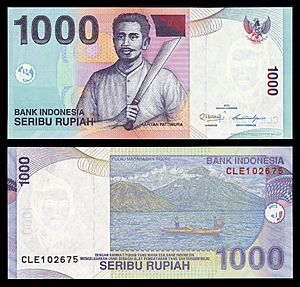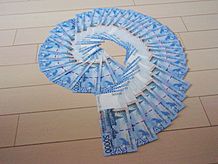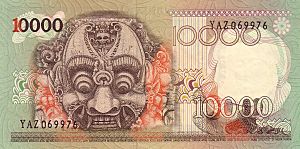Indonesian rupiah facts for kids
Quick facts for kids |
|||
|---|---|---|---|
|
|||
| ISO 4217 Code | IDR | ||
| Official user(s) | |||
| Unofficial user(s) | |||
| Inflation | 2.61% (2023) | ||
| Source | BPS | ||
| Method | CPI | ||
| Superunit | |||
| 103 | ribu (thousand) |
||
| 106 | juta (million) |
||
| 109 | miliar (billion) |
||
| 1012 | triliun (trillion) |
||
| Subunit | |||
| 1⁄100 | sen (cents, obsolete) |
||
| Symbol | Rp | ||
| Plural | The language(s) of this currency does not have a morphological plural distinction. | ||
| Coins | |||
| Freq. used | Rp500, Rp1000 | ||
| Rarely used | Rp50, Rp100, Rp200 | ||
| Banknotes | |||
| Freq. used | Rp1,000, Rp2,000, Rp5,000, Rp10,000, Rp20,000, Rp50,000, Rp100,000 | ||
| Rarely used | Rp75,000 (commemorative) | ||
| Printer | Perum Peruri | ||
|
|||
The rupiah (symbol: Rp; currency code: IDR) is the official money of Indonesia. It is managed by Bank Indonesia, which is like Indonesia's central bank. The word "rupiah" comes from the Sanskrit word rupyakam, which means "silver". Sometimes, Indonesians also informally call it perak, which means "silver" in their language.
The rupiah was first used in 1946 by Indonesian nationalists. They were fighting for independence from colonial rule. It replaced the money that the Japanese government had introduced during World War II. In the beginning, different types of money were used in Indonesia. But eventually, the rupiah became the only official currency. Some parts of Indonesia, like the Riau Islands and West Irian, used to have their own versions of the rupiah. However, these were later combined into the main national rupiah.
Contents
What is Redenomination?
There's a plan to make the rupiah simpler by removing the last three zeroes from its value. For example, Rp10,000 would become Rp10. This is called redenomination.
The idea is to make handling money easier for everyone. Bank Indonesia, the country's money authority, has been suggesting this since 2010. They say it wouldn't change the actual value of your money, just how it's written. The government has tried to pass a law for this, but it hasn't happened yet.
Current Money in Use
Today, you'll find rupiah in coins and banknotes. The coins range from Rp50 to Rp1,000. While Rp1 coins are still official, they are almost never seen. Banknotes go from Rp1,000 up to Rp100,000.
For example, a Rp100,000 banknote is worth about US$6.62 (as of May 2023). Because the smallest banknote is worth so little, people often use banknotes for small payments like bus fares. The Rp1,000 coin is also very common.
Rupiah Coins
There are two main types of coins used today. One series was made between 1999 and 2010, mostly from aluminum and nickel. A newer series of coins came out in 2016. These new coins feature Indonesia's national heroes.
You'll mostly see Rp500 and Rp1,000 coins. Smaller coins like Rp100 and Rp200 are not used as often.
| Indonesian rupiah coins | ||||||||||
|---|---|---|---|---|---|---|---|---|---|---|
| Image | Value | Series | Diameter | Thickness | Weight | Material | Obverse | Reverse | Availability | |
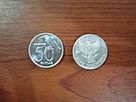 |
Rp50 | 1999 | 20 mm | 2 mm | 1.36 g | Aluminium | Garuda Pancasila | Black-naped oriole bird and coin value | Very low | |
 |
Rp100 | 1999 | 23 mm | 2 mm | 1.79 g | Garuda Pancasila | Palm cockatoo bird and coin value | High | ||
 |
 |
2016 | 23 mm | 2 mm | 1.79 g | Coin value | Herman Johannes and Garuda Pancasila | |||
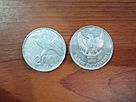 |
Rp200 | 2003 | 25 mm | 2.3 mm | 2.38 g | Garuda Pancasila | Bali myna bird and coin value | |||
 |
 |
2016 | 25 mm | 2.2 mm | 2.38 g | Coin value | Tjipto Mangoenkoesoemo and Garuda Pancasila | |||
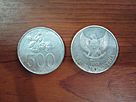 |
Rp500 | 2003 | 27 mm | 2.5 mm | 3.1 g | Garuda Pancasila | Jasmine flower and coin value | |||
 |
 |
2016 | 27 mm | 2.35 mm | 3.1 g | Coin value | T. B. Simatupang and Garuda Pancasila | |||
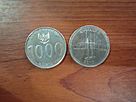 |
Rp1,000 | 2010 | 24.15 mm | 1.6 mm | 4.5 g | Nickel-plated steel | Garuda Pancasila and coin value | Angklung and Gedung Sate | High (mintage 719 million) | |
 |
 |
2016 | 24.10 mm | 1.45 mm | 4.5 g | Coin value | I Gusti Ketut Pudja and Garuda Pancasila | High | ||
Rupiah Banknotes
Indonesian banknotes that are currently used were printed in different years, starting from 2000. Older banknotes from 1998–1999 are no longer valid. This is partly because they lacked modern security features.
In 2009, a Rp2,000 banknote was introduced. This was meant to help with small transactions. Even though the Rp2,000 note is out, the Rp1,000 note is still widely used.
2016 Banknote Series
In 2016, Bank Indonesia released seven new banknote designs. Each one features a different national hero of Indonesia. These notes also show beautiful Indonesian dances, famous places, and unique flowers.
| Indonesian rupiah banknotes | |||||||||
| Image | Value | Main colour | Description | Date of issue | |||||
| Obverse | Reverse | Obverse | Reverse | ||||||
 |
 |
Rp1,000 | Yellow-Grey | Cut Nyak Meutia | Tifa dance, Banda Neira and Cooktown Orchid | 19 December 2016 | |||
 |
 |
Rp2,000 | Grey | Mohammad Hoesni Thamrin | Piring dance, Sianok Canyon and Mangnolia champaca | ||||
 |
 |
Rp5,000 | Light Brown | Idham Chalid | Gambyong dance, Mount Bromo and Tuberose | ||||
 |
 |
Rp10,000 | Purple | Frans Kaisiepo | Pakarena dance, Wakatobi National Park and Magnolia vrieseana | ||||
 |
 |
Rp20,000 | Light Green | Sam Ratulangi | Gong dance, Derawan Islands and Coelogyne pandurata | ||||
 |
 |
Rp50,000 | Blue | Djuanda Kartawidjaja | Legong dance, Komodo National Park and Plumeria | ||||
 |
 |
Rp100,000 | Red | Sukarno and Mohammad Hatta | Topeng Betawi dance, Raja Ampat Islands and Moon Orchid | ||||
In 2020, a special Rp75,000 banknote was released to celebrate Indonesia's 75th Independence Day. It featured Sukarno and Mohammad Hatta, who were key figures in Indonesia's independence. Bank Indonesia plans to replace the 2016 series with a newer 2022 series in the coming years.
2022 Banknote Series
A brand new set of banknotes was introduced on August 18, 2022. These notes also feature Indonesian dances and national heroes, similar to the 2016 series, but with some updated designs. They were officially made legal tender on August 17, 2022, to mark Indonesia's 77th Independence Day.
| Rupiah notes '2022' series, Printed by Perum Peruri | ||||||||||||
| Image | Value | Dimensions | Main Colour | Description | Date of | Remarks | ||||||
| Obverse | Reverse | Obverse | Reverse | Watermark | Signatures | Serial | note series | issue | ||||
| Rp1,000 | 121 × 65 mm | As 2016 issue (see above) | As in Obverse | Perry Warjiyo (Governor)—Sri Mulyani Indrawati (Minister of Finance) | 3 letters, 6 numbers | '2022' | 17 August 2022 | Imprint 2022 | ||||
| Rp2,000 | 126 × 65 mm | |||||||||||
| Rp5,000 | 131 × 65 mm | |||||||||||
| Rp10,000 | 136 × 65 mm | |||||||||||
| Rp20,000 | 141 × 65 mm | |||||||||||
| Rp50,000 | 146 × 65 mm | |||||||||||
| Rp100,000 | 151 × 65 mm | |||||||||||
| These images are to scale at 0.7 pixel per millimetre. For table standards, see the banknote specification table. | ||||||||||||
How Banknotes are Kept Safe
Banknotes have special features to prevent people from making fake ones.
- Most banknotes are made from cotton fiber. This makes them flexible and hard to tear.
- Some banknotes have a watermark. This is a faint image you can see when you hold the note up to the light.
- Security threads are tiny lines woven into the paper. They can change color or have special designs.
- The numbers on the banknotes are printed in a special way called intaglio printing. This makes them feel raised, which helps blind people know the value of the note.
- Newer banknotes also have features like EURion constellation rings. These are patterns that prevent copying. They also have rainbow printing that changes color when you look at it from different angles.
Digital Rupiah
Bank Indonesia is working on a digital version of the rupiah. This is called the Garuda Project. It's a type of central bank digital currency. This digital rupiah is now officially recognized as a form of the rupiah under Indonesian law.
History of the Rupiah
The money used in Indonesia has a long history. It was influenced by Indian and Chinese cultures. During the time when Indonesia was a colony, people used the Netherlands Indies gulden.
When Japan invaded in 1942, they printed their own version of the gulden. After World War II, Indonesian nationalists introduced the first rupiah on October 3, 1946. For a few years, many different currencies were used. But by 1950, the rupiah became the only official money in Indonesia.
Rupiah Value and Inflation
The rupiah has faced challenges with inflation, which means prices for goods and services go up over time. This makes your money buy less.
Early Years: 1946–1965
In its early days, the rupiah's value was mostly set in black markets. After Indonesia gained independence in 1949, the official exchange rate was Rp3.8 to US$1. However, the government often changed rules about foreign money. This was to control trade and help the government's finances.
These rules sometimes made it hard for businesses. They also led to a big black market for foreign money. The rupiah's official value was often much higher than its real value. This caused problems, especially for people in outer islands who produced raw materials.
Inflation became a huge problem in the 1960s. By 1965, prices were rising by over 600% a year! This made the rupiah almost worthless.
Stability and Growth: 1966–1978
In late 1965, a "new rupiah" was introduced. One new rupiah was equal to 1,000 old rupiah. This was done to fight the extreme inflation.
When Suharto came to power in 1966, he made big economic changes. His team of economists worked to stabilize the economy. They ended government subsidies and removed import restrictions. They also devalued the rupiah to a more realistic value.
These changes helped a lot. Inflation dropped significantly, and the economy started to grow. By 1971, the exchange rate was set at Rp415 to US$1. This rate was kept stable for several years, mainly because Indonesia had strong oil exports.
Managed Float: 1978–1997
By 1978, falling oil prices and lower foreign money reserves meant the rupiah had to be devalued again. It dropped to Rp625 to US$1. The government then started using a "managed float" system. This meant the exchange rate was allowed to change daily, but the government still influenced it.
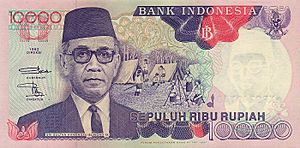

Indonesia devalued the rupiah several more times in the 1980s. This was to make its exports more competitive, especially as oil prices fell. These devaluations helped the economy. From 1986 until 1997, the rupiah's value against the US dollar mostly reflected the difference in inflation between Indonesia and the US. It slowly dropped from Rp1,664 to Rp2,350 against the dollar.
Asian Financial Crisis: 1997–1999
The 1997 Asian financial crisis hit Indonesia hard. In July 1997, the rupiah started to fall sharply. Bank Indonesia tried to control it, but eventually, they had to let the rupiah float freely. It dropped from Rp2,436 to Rp2,955 against the dollar in just over a month.
The government tried to fix the problem by closing some small banks. But people lost trust in the system. Many moved their money out of Indonesian banks or exchanged it for US dollars. This made the rupiah fall even more. By January 1998, it reached a low of Rp14,800 per dollar. This huge drop caused widespread economic problems and led to social unrest.
The government then guaranteed all bank deposits and set up an agency to fix the banking system. Over time, with help from the International Monetary Fund, the rupiah slowly started to recover. By the end of 1999, it was around Rp7,900 to the US dollar.
Rupiah Since 1999: More Stable
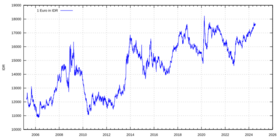
After the crisis, the rupiah's value continued to change. It reached a low of Rp12,069 per dollar in April 2001. However, it generally became more stable in the following years. From 2002 to 2005, it mostly stayed between Rp8,000 and Rp9,000.
During the financial crisis of 2007–2008, the rupiah faced pressure again. It fell below Rp10,000 and even Rp11,000 per dollar. Bank Indonesia took steps to support the currency, and it eventually strengthened a bit.
More recently, the rupiah has seen some ups and downs. In September 2018, it reached Rp14,880 per dollar. During the COVID-19 pandemic in March 2020, it dropped to nearly Rp16,650. However, it recovered later that year. In April 2024, it fell to the Rp16,000 level again.
The rupiah is one of the currencies with a very low value compared to others like the US dollar. In everyday conversations in Indonesia, people often just say "thousand," "million," or "billion" instead of "rupiah" when talking about money amounts.
| Current IDR exchange rates | |
|---|---|
| From Google Finance: | AUD CAD CHF EUR GBP HKD JPY USD SGD EUR JPY |
| From Yahoo! Finance: | AUD CAD CHF EUR GBP HKD JPY USD SGD EUR JPY |
| From XE.com: | AUD CAD CHF EUR GBP HKD JPY USD SGD EUR JPY |
| From OANDA: | AUD CAD CHF EUR GBP HKD JPY USD SGD EUR JPY |
| From fxtop.com: | AUD CAD CHF EUR GBP HKD JPY USD SGD EUR JPY |
See Also
 In Spanish: Rupia indonesia para niños
In Spanish: Rupia indonesia para niños
- Economy of Indonesia
- Netherlands Indies gulden
- Netherlands New Guinean gulden
- Riau rupiah
- West Irian rupiah



